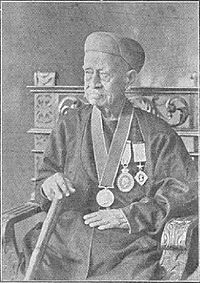R. Raghunatha Rao facts for kids
Quick facts for kids
Rai Raghunatha Rao
|
|
|---|---|

Portrait of R. Raghunatha Rao
|
|
| Diwan of Indore | |
| In office 1875–1881 |
|
| Monarch | Tukojirao Holkar II |
| Preceded by | Sir T. Madhava Rao |
| Succeeded by | Shahamat Ali |
| In office 1886–1888 |
|
| Monarch | Shivajirao Holkar |
| Preceded by | Nana Moroji Trilokekar |
| Succeeded by | Balkrishna Atmaram Gupte |
| Personal details | |
| Born | 7 February 1831 Kumbakonam, Thanjavur Maratha kingdom |
| Died | 3 May 1912 (age 81) Madras, British India |
| Political party | Indian National Congress (founder) |
| Relations | R. Venkata Rao (father), T. Ranga Rao, Sir T. Madhava Rao (cousin), T. Ananda Rao (nephew) |
| Alma mater | Presidency College, Madras |
| Occupation | Civil servant, Administrator |
Diwan Bahadur Rai Raghunatha Rao (born February 7, 1831 – died May 3, 1912) was an important Indian leader. He worked as a civil servant, a government administrator, and a politician. He also helped with India's fight for independence.
Raghunatha Rao served as the Diwan (like a chief minister or prime minister) of the state of Indore two times. He was related to another famous Indian leader, Sir T. Madhava Rao.
Contents
Early Life and Learning
Raghunatha Rao was born in February 1831 in a town called Kumbakonam. His family was a well-known Marathi family. His father, R. Venkata Rao, had also been a Diwan in another state called Travancore.
Raghunatha Rao was the cousin of Sir T. Madhava Rao. Sir T. Madhava Rao later became a Diwan for Travancore, Indore, and Baroda. Raghunatha Rao went to school in Bangalore and then studied at Government High School in Madras (which is now Presidency College, Madras).
He also studied law on his own and earned a diploma in 1856. But instead of becoming a lawyer, he decided to work for the government in Madras.
Working for the Government
Raghunatha Rao started his career as a translator. This means he changed words from one language to another. He worked in the office of the District Collector, who was a main government official.
He worked his way up and became a Sheristadar, and then a Deputy Collector for the Madras District. He also worked on a special project called the Tungabhadra Project. This was a big project to manage water resources. Later, he moved to work in other districts like Trichinopoly and Coimbatore.
In 1873, Raghunatha Rao met Tukojirao Holkar II, who was the ruler of the state of Indore. Two years later, the ruler asked Raghunatha Rao to come work for Indore as a Special Settlement Officer. This job involved managing land and taxes. Later that same year, he took over from his cousin, Sir T. Madhava Rao, as the Diwan of Indore.
Leading Indore State
In 1875, Raghunatha Rao officially became the Diwan of Indore. He took over from his cousin, Madhava Rao. People thought his time as Diwan was a period of good progress for the state. He was known for choosing the best and most skilled people for important jobs in the courts.
Raghunatha Rao went back to Madras in 1880. But he returned to Indore in 1886 and served as Diwan again for about two years.
Community Involvement
Raghunatha Rao was a very active person in his community. He helped start two important groups: the Madras Mahajana Sabha and the Indian National Congress. These groups were important for discussing public issues and working towards India's future.
In December 1887, the first ever Indian National Social Conference was held at Raghunatha Rao's house in Madras. This conference was a big event where people talked about social issues in India. His cousin, Sir T. Madhava Rao, was the leader of this conference.
After Raghunatha Rao passed away, a statue of Krishna was put up in front of the Kumbakonam Town Hall in 1913. It was put there to honor him and his contributions.

